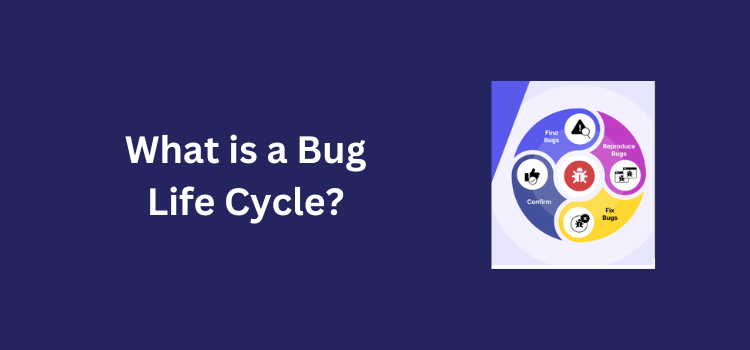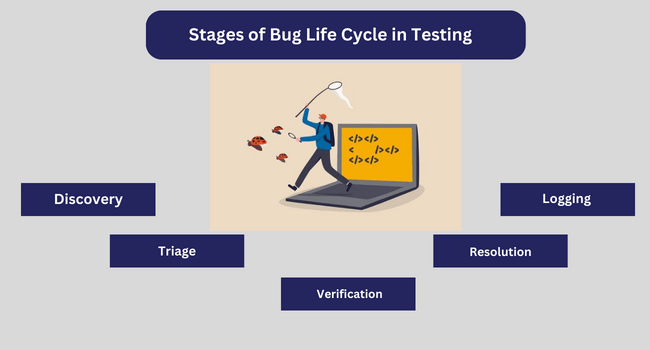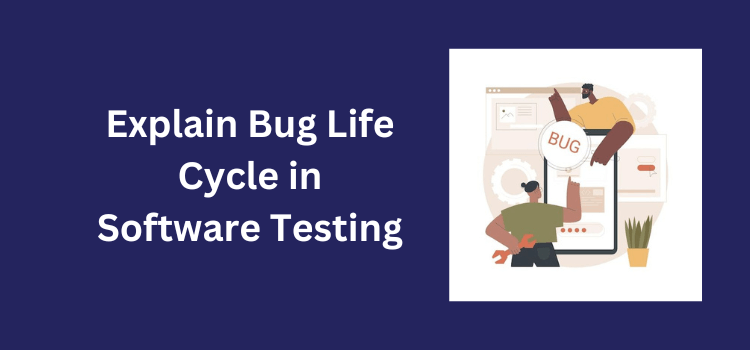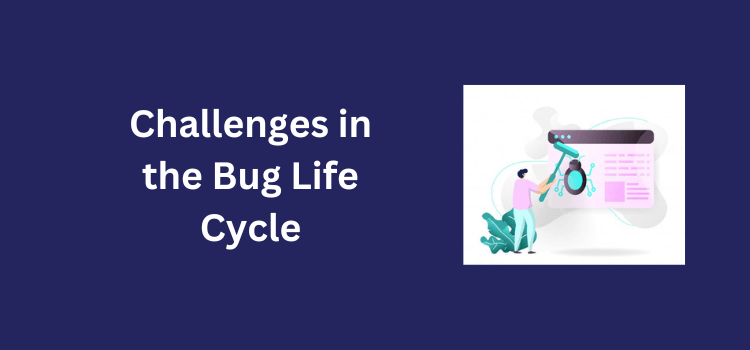Software development is a fascinating journey, blending creativity, logic, and sometimes, a dash of chaos. But what happens when that chaos manifests as a glitch or error? That’s where the “bug life cycle in software testing” enters the spotlight.
It’s a structured process that ensures every software hiccup, from the tiniest glitch to a system crash, is detected, addressed, and resolved. It explains what software bugs are, how they’re managed, and what teams can do to deliver seamless software.
So, whether you’re a seasoned developer, an enthusiastic beginner, or just curious, join us as we unravel the intricate dance of software bugs and their lifecycle.
What is a Bug in Software Testing?
In the digital world, we all crave glitch-free software experiences. But, alas, hiccups occur! In software testing, these hiccups are called ‘bugs’. Imagine working on a spreadsheet and it crashes unexpectedly – that’s a bug in action.
It’s an error or flaw causing the software to produce incorrect or unintended results. As testers dive deep into bug testing, they aim to catch these sneaky discrepancies before they reach you, the user.
And while we’re on the topic, ever confused a ‘bug’ with a ‘defect’? They may seem similar, but there’s a subtle difference between bug and defect. Essentially, a bug emerges during testing, whereas a defect pops up when the end-user interacts with the software.
Understanding these nuances is key to the bug life cycle in testing, ensuring every glitch is caught and corrected.

What is a Bug Life Cycle?
Let’s envision software testing as a thrilling detective story. Here, our experts (testers) are always on the hunt for culprits (bugs). When they find one, it isn’t just thrown into jail.
Instead, it undergoes a captivating journey known as the software bug life cycle.
This journey charts the bug’s course from its discovery to its eventual resolution. Think of it as the life stages of a butterfly, from an egg (discovery) to its full glory (resolution).
But why is this process so crucial?
Advantages of Defect Life Cycle
The magic of the bug life cycle in testing lies in its organized approach.
- First, it ensures that no bug, big or small, goes unnoticed.
- Secondly, by distinguishing between bug and defect, teams can prioritize issues based on their severity.
- Lastly, this structured flow fosters effective communication, ensuring every team member is in sync, thereby elevating the overall software quality.
In essence, it’s the blueprint that streamlines bug finding, setting the stage for flawless software delivery.
Participants of a Bug Life Cycle
Imagine the creation of a blockbuster movie. You have directors, actors, cinematographers, and more, each playing a crucial role in bringing the vision to life.
Similarly, the bug life cycle has its ensemble cast, each pivotal in ensuring software glows without a hitch.
Testers
These are the vigilant eyes who first spot the bugs, setting the bug life cycle in motion. It’s their detective work that ensures the software’s health checkup is thorough.
Developers
Once testers spotlight software errors, these tech wizards roll up their sleeves, diving deep to craft a fix. They’re the problem-solvers in our bug test saga.
Product Managers
The tacticians, then join the fray. Weighing the bug and defect difference, they strategize and prioritize which issues to tackle first. Their decisions influence the software’s overall health and user satisfaction.
QA Leads
Think of them as the final gatekeepers. They double-check, validate, and ensure the fixes hold up under scrutiny. They’re the quality stamp, ensuring the bug life cycle in testing results in stellar software.
Together, this quartet orchestrates the nuances of the bug life cycle, championing the cause of flawless software for all users

Stages of Bug Life Cycle in Testing
Software development is an intricate dance of creating, testing, and refining. Central to this rhythm is understanding the “bug life cycle in software testing.” It’s a sequence of steps ensuring that every hiccup, every glitch, is identified and ironed out.
Let’s dive into the stages that define this crucial cycle:
Discovery
This is where our journey begins. During a bug test, a tester encounters an irregularity in the software. Like a detective finding a clue, the bug’s journey starts.
Logging
Once discovered, it’s crucial to document the bug. This step involves creating a detailed record of the issue, capturing its nature, and noting its impact.
Triage
At this juncture, product managers weigh in. They evaluate the gravity of the issue, determining the difference between bug and defect. It’s here that priorities are set, deciding which issues to tackle head-on.
Resolution
Enter our developers. Armed with the bug’s dossier, they craft a solution, rectifying the glitch to ensure premium software quality.
Verification
Lastly, it circles back to our testers. They verify the fix, ensuring that the solution holds firm and the bug no longer lurks.

Explain Bug Life Cycle in Software Testing
Every software, no matter how meticulously crafted, isn’t immune to the occasional glitch or bug. From its discovery to its demise, the testing bug life cycle is the main narrative.
What Sparks the Cycle?
It all begins with bug testing. A tester, while going through the software, stumbles upon an inconsistency, a behavior that deviates from the expected. That’s our origin story.
The Lifecycle Pathway
Once identified, the bug is documented and logged into a tracking system. Depending on its nature and severity (is it a mere bug or a more pressing defect?), it’s prioritized for a fix.
Developers then delve into the depths of code, crafting a remedy for the identified glitch.
But, the story doesn’t end with a fix. It circles back to the testing team, which rigorously verifies that the solution indeed rectifies the problem.
The Grand Finale
Post-verification, if the bug stands corrected, it’s marked as resolved. If it re-emerges, the cycle resets, ensuring rigorous scrutiny till perfection.
Difference Between Bug and Defect
In the vast world of software testing, two terms often intertwine, creating a blend of confusion: ‘bug’ and ‘defect’. While they might seem like twins in the life cycle of software bugs, they possess distinct identities.
Let’s unravel this mystery.
| Aspect | Bug | Defect |
| Terminology | Often used interchangeably with “defect” | Commonly used term in software quality assurance |
| Origin | Typically used informally by developers | Formally used in software testing processes |
| Scope | Can refer to any unexpected behavior | Generally refers to functional issues |
| Severity | Can vary in severity | Usually implies high-severity issues |
| Priority | Can vary in priority | Indicates the urgency of fixing |
| Detection | Found in development or after deployment | Usually identified during testing or post-release |
| Stage | Can be present at any development stage | Typically found during testing phase |
| Reporting | Reported by developers or end users | Reported by testers or end users |
| Context | May include coding errors, logic issues | Generally relates to functional problems |
| Impact | Can have varying impact on software | Can directly affect software’s functionality |
| Resolution | Requires investigation and fixing | Requires debugging and re-coding |
| Communication | Informal discussions among developers | Formally documented in defect reports |
| Lifecycle | Part of software development lifecycle | Part of software testing and QA lifecycle |
| Management | Managed by developers and project team | Managed by QA teams and stakeholders |
| Closure | Closed after the bug is fixed | Closed after the defect is rectified |
How to Report and Track a Bug?
Identifying a bug is just the beginning of its journey in the “bug life cycle in software testing.” Equally crucial is ensuring it’s reported effectively and tracked diligently, setting the stage for swift resolutions and high-quality software delivery.
Drafting the Bug Report
Crafting an articulate bug report is the first step. It’s more than just noting down an issue; it’s about communicating the essence of the problem.
Ensure the report includes —
- A clear title that captures the bug’s nature.
- Steps to reproduce the issue, creating a pathway for developers.
- Attachments or screenshots for a visual understanding.
- The expected versus the actual result, highlighting the deviation.
Choosing the Right Bug Tracking Tools
While manual tracking works for small projects, as complexity grows, leveraging specialized bug tracking tools becomes paramount. Using tools like JIRA or Bugzilla streamlines the reporting process and aids in visualizing the bug life cycle during testing.
Keeping Stakeholders in the Loop
Communication is the linchpin. As the bug maneuvers through different stages, keeping relevant stakeholders informed ensures alignment. The tester can provide additional details or the developer can provide clarification, but open channels promote effective bug resolution.
Tools for Detecting and Reporting Bugs
Navigating the intricate maze of software testing is smoother when you’re equipped with the right tools. It is especially important to have cutting-edge tools when it comes to the software testing bug lifecycle.
Automation: The Modern Scout
Harnessing the power of test automation transforms bug detection. Tools like Selenium autonomously comb through web applications, identifying issues that might evade the human eye. Automation not only speeds up the process but also adds a layer to precision.
Real-time Vigilance with Dynamic Analysis
Tools such as Valgrind offers a live playback of the software’s behavior. By dynamically analyzing operations, they unearth deeper issues like memory leaks, ensuring every potential pitfall is flagged.
Reporting Platforms: The Unsung Heroes
Discovering a bug is just one part of the equation. Reporting tools like JIRA and Bugzilla play a critical role in the bug life cycle in testing. Their intuitive dashboards provide an at-a-glance view of ongoing issues, making tracking and resolution streamlined.
Bridging Gaps with Integrated Tools
MantisBT stands out by offering a holistic approach. It doesn’t just spotlight the thread of bug vs defect; it actively fosters collaboration. By serving as a conduit between developers, testers, and stakeholders, it ensures everyone is on the same page.
How to Write a Good Bug Report?
In the world of software testing, communicating issues effectively is just as vital as finding them. A clear, comprehensive bug report can be the beacon that guides developers toward a swift resolution.
But what constitutes a ‘good’ report?
Be Specific with Your Titles
Start with a title that immediately paints a picture. Instead of saying “Feature X doesn’t work,” try “Feature X crashes when option Y is selected.” This precision not only helps prioritize the issue but also provides a quick glimpse into the bug’s nature.
Detailed Steps for Reproduction
A developer’s detour into reproducing the bug should be obstacle-free. List out every step, from the start to the point where the bug manifests. This clarity minimizes back-and-forths and accelerates the resolution process.
Visual Aids Speak Volumes
Whether it’s a screenshot or a short video clip, visual evidence can underline the distinction between bugs and defects. They showcase the bug in action, making it easier for developers to pinpoint the problem.
Set Expectations Right
Define the gap. State what you expected versus what actually transpired. This not only clarifies the issue but also aligns everyone on the desired outcome.
Use the Right Tools
While the content of your report is crucial, the platform you choose plays a role too. Utilizing tools geared towards bug reporting ensures your findings are logged and tracked efficiently through the bug life cycle in testing.
Who Performs a Bug Life Cycle?
In the bustling realm of software development, ensuring a product’s quality is a shared responsibility. But when it comes to the “bug life cycle,” specific roles steer this ship, each playing a pivotal part in ensuring software stands tall against any storm
Testers & Quality Analysts
Often the front liners, testers, and quality analysts are the eagle-eyed individuals who scout for bugs. With a keen focus on quality, they rigorously vet software to uncover any hitches.
Developers
Once a bug is spotted, developers jump into the fray. They dissect the problem, delve into the code, and craft solutions to rectify the glitch. Their role is pivotal in moving bugs from ‘identified’ to ‘resolved.’
Project Managers
Overseeing the bug life cycle’s smooth progression, project managers act as the linchpin. They prioritize issues, allocate resources, and ensure every team member is aligned with the project’s goals.
Stakeholders & End-users
Sometimes, those using the software – be it stakeholders or end-users – stumble upon issues that might’ve slipped through. Their feedback is invaluable, acting as an additional layer of review.

Challenges in the Bug Life Cycle
While the bug life cycle serves as a roadmap guiding software teams from detection to resolution, navigating this path isn’t always straightforward.
Challenges, both anticipated and unforeseen, can pop up, testing the team’s mettle and agility.
Ambiguous Software Bug Reports
One major hiccup arises when bug reports lack clarity. Vague descriptions can send developers on wild goose chases, leading to wasted time and unresolved issues.
Prioritization Pitfalls
With a plethora of bugs detected, prioritizing them becomes crucial. Misjudging the severity of a bug can result in significant glitches getting overlooked in favor of minor ones.
Communication Gaps
As testers, developers, and managers collaborate, ensuring seamless communication becomes paramount. A missed email or an unclear update can derail the resolution process.
Tools and Technical Limitations
Even the most seasoned teams can face setbacks due to tool limitations. Whether it’s software that doesn’t capture enough data or a tool that’s incompatible with certain platforms, these hitches can slow down the cycle.
Best Practices for Bug Life Cycle Implementation
It takes more than just sharp eyes and coding skills to handle the complex world of software glitches. It demands a structured approach to ensure that the entire bug life cycle in testing unfolds efficiently.
Implementing best practices can make this journey smoother and more effective.
Clear Documentation
Begin with crystal-clear documentation. Whether it’s the difference between bug and defect or the steps to reproduce an issue, clarity can prevent a lot of back-and-forths, saving precious time.
Prioritize Effectively
All bugs aren’t created equal. Some can crash a system, while others are mere cosmetic issues. Prioritizing based on severity ensures that critical issues get immediate attention, reducing potential damage.
Foster Open Communication
Bug detecting is a collaborative effort. Encouraging open lines of communication between testers, developers, and managers ensures everyone is on the same page and can respond promptly to any changes or updates.
Use Robust Tools
Equip your team with efficient tools tailored for tracking and managing bugs. Such tools not only streamline the process but also ensure no bug slips through the cracks.
Wrapping up
Navigating the vast landscape of software development is no mean feat. But with processes like the bug life cycle in software testing in place, the journey becomes more manageable and structured.
During this process, we examined the different stages, explored the key players, and even explored best practices to ensure a smooth bug resolution.
In essence, it’s all about collaboration, clarity, and commitment to quality. With these principles in mind and continuous refinement of our processes, we move closer to delivering software that exceeds user expectations.
Keep testing, keep refining, and remember – every bug resolved is a step closer to perfection.
Frequently Asked Questions
What’s the difference between a bug and a defect in software testing?
While often used interchangeably, a bug typically refers to an error in the code, while a defect is when the software doesn’t meet the requirements, even if the code is correct.
How long does a typical bug life cycle in testing last?
The duration can vary based on the bug’s severity, the software’s complexity, and team responsiveness. While minor bugs can be resolved within hours, critical ones might take days or even weeks.
Why is open communication crucial in managing software bugs?
Open communication ensures everyone is updated about the bug’s status, reducing duplication of effort, ensuring faster resolution, and keeping the team aligned with the project’s goals.
- Top 10 Cross Browser Testing Tools: The Best Choices for 2024 - October 28, 2025
- 5 Best API Testing Tools: Your Ultimate Guide for 2024 - October 26, 2025
- Top 5 Regression Testing Tools: Comprehensive Review & Guide - October 26, 2025
